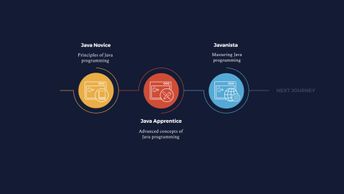Aspire Java Novice to Javanista Java Novice to Javanista Track 3: Javanista
Final Exam: Javanista will test your knowledge and application of the topics presented throughout the Javanista track of the Aspire Java Novice to Javanista Journey.
| Objectives |
Final Exam: Javanista - allow end-users to delete rows from a database table through the UI of your JSP app
- configure JDBC objects to connect to a database
- connect to a database from a RESTful Java application
- consume a REST API by sending a GET request and processing its response
- create a database schema and table and load it with data
- create a Maven project which uses the MySQL connector
- create and configure a web service project that works with Java objects
- define a web service method that responds to a request by returning text
- delete data on a database by processing a DELETE request
- deploy and test the connectivity from your JSP app to a database and ensure that queried data is displayed correctly
- deploy your SOAP-based application as a WAR file to a Tomcat server
- describe how the connected nature of a JdbcRowSet can be used to get any updates to the underlying data
- describe the behavior of a batch execution where some queries are invalid
- describe the different methods available to access the data and metadata in an HttpResponse instance
- describe the role of a HEAD request to obtain information about a resource
- describe the similarities between a JdbcRowSet and a CachedRowSet
- describe the WSDL file for a web service and recognize its properties
- download and set up the Apache Maven build automation tool
- execute SELECT queries against a database using a JDBC Statement
- explore exceptions that arise when parsing json data
- handle incoming HTTP requests
- implement a join operation in a Java program using a JDBC JoinRowSet
- install and configure Apache Tomcat server
- install Maven and use it to create a web service app
- join multiple tables involving different join fields using a JoinRowSet
- perform a batch execution of parameterized queries using a PreparedStatement
- read and write json data using org.json
- recall how the JSON format structures primitives, entities, and arrays
- recall the role of the serialVersionUID field
- recognize some of the important settings of a JdbcRowSet and what their default values are
- recognize the differences between a JdbcRowSet and a CachedRowSet
- recognize the power of the WebServlet annotation when it comes to mapping servlets to URL endpoints
- recognize the types of join operations which are supported by a JoinRowSet implementation
- recognize the various fields available in response to an HTTP GET request
- serialize objects with nested object references
- set an upper limit on the amount of time you can wait for a response to an HTTP request
- set up a JSP page to direct an end-user to a specific error page in the event of an exception being thrown
- set up a Maven project to build the HTTP client application
- set up an Apache Maven project and specify dependencies
- set up Apache Tomcat web server that can be used to serve a JSP application
- set up a web application with Maven and configure a POM file for a RESTful app
- set up a web method that performs a delete operation in a database
- set up MySQL server on your machine
- set up the environment to perform hands-on coding
- set up your machine with a MySQL server and a client application to interact with it
- tokenize strings using the string tokener
- unpack and view the contents of the WAR archive for a JSP application and describe its structure and properties
- use Apache Maven to build a stub web application
- use a Statement object to run a series of INSERT queries as a batch
- use a web.xml file to define a common error page for an entire JSP application
- use a web.xml file to define a common error page for the entire JSP application
- use JDBC to connect to and query a SQL database from a JSP app
- use json-simple to read in and write out JSON data
- use the HttpClient class to send a GET request and process the response, which is returned
- use the HttpURLConnection to configure and send an HTTP GET request
- use the Jersey framework to define a method that responds to GET requests
- use the org.json library for JSON parsing
- use the transient modifier to omit fields from serialization
- verify the behavior of a web service app deployed to a Tomcat server
- write json data using org.json
|


